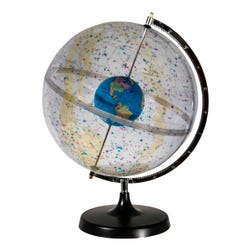United Scientific Celestial Star Globe
Description
Three dimensional representation allows the relative angular positions of the constellations to be visualized and permits students to estimate which stars will be visible from different places on Earth for any rotational position of the planet. The globe consists of two concentric spheres mounted on a common axle and supported on a frame with a base.
The inner sphere (1) in the above illustration) is 4 inches in diameter and represents the Earth. The continents are marked on it in their correct relative positions. The outer sphere (2) is transparent. It is 12-1/2 inch in diameter and has the constellations and their stars marked on it. Yellow shading indicates the Milky Way, the plane of our galaxy. The axle (3) that carries both spheres allows them to be rotated independently. An angle scale is marked on the frame (4) that supports the axle. The angles are marked every degree and extend from zero at the equator to 87 degrees in both directions. The frame is fixed to a round base (5) so that the axle is held at an angle of 23-1/2 degrees to the vertical, representing the inclination of the Earth’s spin axis to the axis of its orbit around the sun.
Features
- First person experiences are the best way to spark student connection
- Everything needed for student exploration is included
- Creates a lifelong love of learning in students




